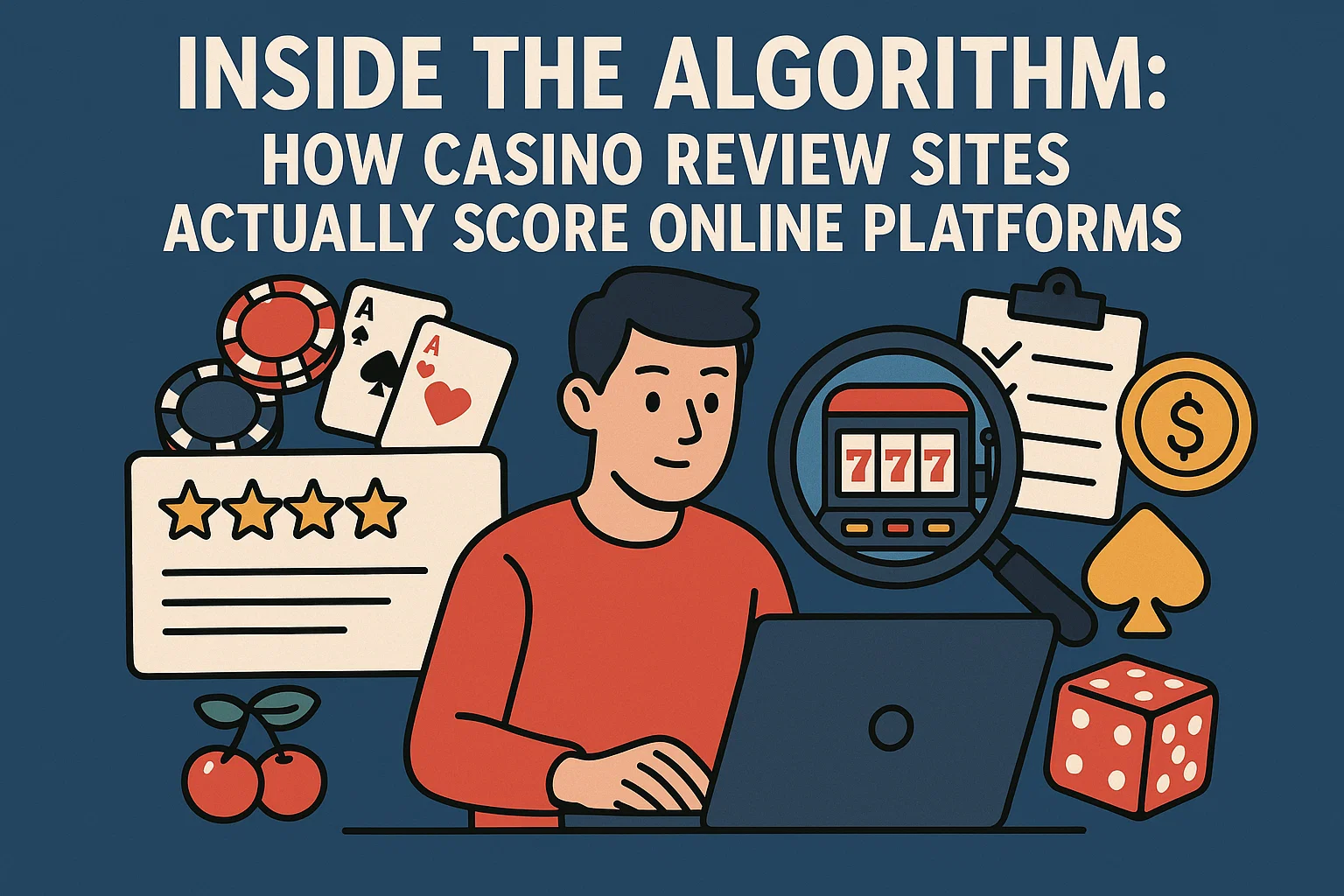Inside the Algorithm: How Casino Review Sites Actually Score Online Platforms

The global online casino market, valued at approximately $248 billion in 2022, depends heavily on review sites that guide millions of players toward trustworthy platforms. But how exactly do these review sites determine which casinos deserve top rankings? The answer lies in sophisticated algorithms that analyze hundreds of data points, creating what amounts to a complex scoring ecosystem that most players never see.
As someone who’s spent years analyzing the intersection of technology and gambling, I’ve discovered that the methodologies behind casino review algorithms are far more intricate than most realize. These systems have evolved from simple checklists into sophisticated analytical frameworks that rival those used by major tech companies for product recommendations.
The Data-Driven Foundation of Modern Casino Reviews
Algorithmic Complexity in Review Scoring
Modern casino review sites employ algorithms that analyze 200-500+ data points, creating comprehensive evaluations that go far beyond surface-level assessments. These systems use rigorous, data-driven approaches to review and rate gaming platforms on a 1 to 10 scale, with ratings incremented in tenths of a point to ensure nuanced and accurate assessments (e.g., 7.3, 8.8, 9.1).
The sophistication of these algorithms reflects the industry’s maturation. Where early casino reviews relied primarily on subjective opinions, today’s systems incorporate:
- Mathematical modeling for fair comparisons across diverse platforms
- Real-time data integration from multiple sources
- Weighted scoring matrices that prioritize critical safety factors
- Automated bias detection to maintain objectivity
The Science of Z-Score Normalization
Review sites use data normalization, specifically Z-scores, in their casino evaluations to ensure fair and consistent comparisons across platforms. Z-scores allow them to standardize each criterion, such as bonus amounts or payout speed, by comparing each casino’s score against the average for that criterion.
This statistical approach addresses a critical challenge in casino reviews: how do you fairly compare a casino offering a $50 bonus with one offering $5,000? Z-score normalization provides the answer by measuring each casino’s performance relative to industry averages, preventing extreme outliers from distorting the overall scoring system.
Weighted Scoring: The Hidden Hierarchy of Importance
Strategic Priority Assignment
Casino review methodologies assign different weights to various factors, with some being more important than others. For example, casino bonuses and promotions might count for 20%, while user experience counts for 10%. This weighted approach reflects the industry’s understanding of what truly matters for player safety and satisfaction.
The typical weighting hierarchy reveals interesting priorities:
High-Priority Factors (15-25% weight each):
- Security and licensing verification
- Financial stability and payout reliability
- Game fairness and RNG certification
- Customer complaint resolution history
Medium-Priority Factors (10-15% weight each):
- Game variety and software quality
- Bonus terms and promotional value
- Payment method diversity and speed
Lower-Priority Factors (5-10% weight each):
- Mobile compatibility and design
- Language support and localization
- Live chat response times
Industry-Specific Adaptations
The weighting systems adapt significantly based on casino type. Crypto casino reviews prioritize different factors, focusing heavily on no-KYC accessibility, provably fair gaming algorithms, and blockchain transparency features. Traditional online casinos, meanwhile, emphasize regulatory compliance and established banking relationships.
The Testing Process: From Automated Analysis to Human Verification
Multi-Stage Verification Protocols
Review processes are hands-on and data-driven, with casinos needing to consistently rank in the top third across every category to be considered standouts. Leading review sites create accounts, make deposits using various payment methods, and play different games to assess the user journey, payout speed, and overall functionality.
The comprehensive testing methodology typically includes:
- Automated data collection across regulatory databases
- Financial analysis of ownership and operational stability
- Software integration testing for game fairness verification
- Manual user experience evaluation across devices and platforms
- Complaint database cross-referencing for reputation verification
Real-Money Testing Protocols
Review teams conduct real testing with cryptocurrency and traditional banking methods, making actual deposits and evaluating withdrawal processes to provide authentic assessments. This hands-on approach provides insights that purely algorithmic analysis cannot capture, such as the actual user experience during high-stress situations like large withdrawals or customer service disputes.
Aggregation Models: The Meta-Analysis Approach
Multi-Source Data Integration
Leading review platforms provide aggregate ratings made up of rankings from other trusted review sites like ‘Casino.guru’ and ‘AskGamblers’, offering a full picture of how casinos are rated elsewhere. This meta-analytical approach addresses the limitation of single-source bias while providing readers with comprehensive perspectives.
The aggregation process involves:
- Cross-platform data synchronization from multiple review sources
- Weighted averaging based on source credibility and methodology transparency
- Outlier detection to identify potentially biased or manipulated reviews
- Temporal analysis to track reputation changes over time
User Feedback Integration
Once a casino receives at least 15 user reviews, platforms calculate User feedback scores ranging from Terrible to Excellent. Review teams pay attention to real users’ feedback by reading player reviews, forums, and complaints, analyzing trends in player satisfaction to highlight what users love and warn about potential red flags.
The Transparency Challenge: Balancing Openness with Gaming the System
Proprietary Algorithm Protection
The casino review industry faces a fundamental tension between transparency and algorithm integrity. While the exact mathematical formulas are proprietary, casinos often provide information on their RNG systems and fairness testing, with transparency being key to building trust with players.
Review sites must navigate this same challenge. Complete algorithm transparency would allow casinos to game the system, while complete opacity undermines user trust. The solution involves:
- Methodology disclosure without revealing specific formulas
- Regular third-party audits of review processes
- Open-source components for non-sensitive calculations
- Public complaint resolution processes for disputed reviews
Regulatory Compliance and Standards
Review methodologies undergo regular revision to stay updated with industry trends, changes in the iGaming industry, and new technologies, with teams consulting industry experts before making formal decisions. This adaptive approach ensures that review algorithms remain relevant as the industry evolves.
Emerging Challenges: AI, Crypto, and Market Evolution
Artificial Intelligence Integration
Advanced AI algorithms now analyze user behavior and offer personalized game recommendations, with AI also assisting in improving customer support through chatbots that can solve problems and assist with responsible gambling tools. Review algorithms must now evaluate these AI-powered features, adding new complexity to scoring systems.
The integration of AI creates new evaluation criteria:
- Personalization engine effectiveness
- Responsible gambling AI implementation
- Predictive analytics accuracy
- Bias detection in AI recommendations
Blockchain and Provably Fair Gaming
Crypto casinos utilize provably fair algorithms and transparent blockchain records to verify every spin or bet, with players able to audit outcomes in real-time. This technological advancement requires review algorithms to incorporate new verification methodologies that traditional audit approaches cannot address.
The Future of Casino Review Algorithms
Predictive Analytics and Market Intelligence
The evolution toward predictive scoring models represents the next frontier in casino review algorithms. Rather than simply evaluating current performance, these systems will assess:
- Market trajectory indicators for long-term sustainability
- Technology adoption patterns for future competitiveness
- Regulatory compliance trends across multiple jurisdictions
- Player behavior predictions based on demographic shifts
Standardization vs. Innovation Balance
The lack of standardized reporting frameworks affects comparative analysis, with future research focusing on the development of standardized methodologies and investigation of automated audit tools. The industry moves toward greater standardization while maintaining innovation in evaluation techniques.
Key Takeaways for Players and Industry Stakeholders
The sophistication of modern casino review algorithms reflects the industry’s commitment to player protection and market transparency. However, understanding these systems’ limitations remains crucial:
For Players:
- Review scores represent algorithmic assessments, not guarantees
- Multiple review sources provide better perspective than single ratings
- Recent reviews and real user feedback often reveal current operational status
For Casino Operators:
- Algorithm transparency builds trust more effectively than gaming scores
- Consistent performance across multiple review platforms indicates genuine quality
- Investment in measurable improvement areas yields better long-term ratings
For Industry Regulators:
- Standardized review methodologies could improve market transparency
- Algorithm auditing requirements might enhance consumer protection
- Cross-border collaboration on review standards could benefit global players
The casino review algorithm ecosystem continues evolving, driven by technological advancement and changing player expectations. Understanding these systems’ mechanics helps stakeholders make more informed decisions in an increasingly complex digital gambling landscape.
As the industry matures, the algorithms scoring our favorite platforms become more sophisticated, more transparent, and more essential to maintaining trust in the digital gambling economy. The future promises even greater precision in these evaluations, ultimately benefiting players, operators, and the industry as a whole.
